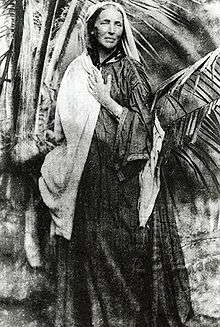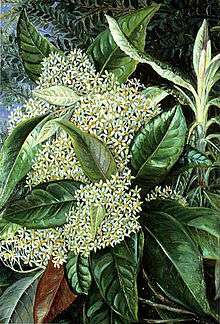Marianne North
| Marianne North | |
|---|---|
 at her home in Ceylon. Photograph by Julia Margaret Cameron, before 1879 | |
| Born |
October 24, 1830 Hastings |
| Died |
August 30, 1890 (aged 59) Alderley, Gloucestershire |
Marianne North (24 October 1830 – 30 August 1890) was a prolific English Victorian biologist and botanical artist, notable for her plant and landscape paintings, her extensive foreign travels, her writings, her plant discoveries and the creation of her gallery at the Royal Botanic Gardens, Kew.
Life with her parents
Marianne North was born on 24 October 1830 in Hastings, the eldest daughter of a prosperous land-owning family descended from the Hon. Roger North, younger son of Dudley North, 4th Baron North. Her father was Frederick North, a Norfolk Deputy Lieutenant and Justice of the Peace, and Liberal M.P. for Hastings. Her mother, Janet, was the daughter of Sir John Marjoribanks M.P., 1st Baronet of Lees in the County of Berwick.[1]
She trained as a vocalist under Charlotte Helen Sainton-Dolby, but her voice failed, and she then devoted herself to painting flowers. After the death of her mother in 1855, she constantly travelled with her father, who was then member of parliament for Hastings; and on his death in 1869 she decided to pursue her early ambition of painting the flora of distant countries.[1]
Travel and work

Marianne North travelled with her father in Syria and along the Nile in 1865-67. After her father's death in 1869 she travelled and made paintings in Sicily.[2] In 1871–1872, she travelled to Canada, the United States and Jamaica, and spent a year in Brazil, where she did much of her work at a hut in the depths of a forest. In 1875, after a few months in Tenerife, she began a journey round the world, and for two years painted the flora of California, Japan, Borneo, Java and Ceylon. During her visits to California, she recorded her concern with the destruction of the redwoods.[3] She spent all of 1878 in various parts of India.[1]
On her return to Britain she exhibited a number of her drawings in London. She offered to give the collection to the Royal Botanic Gardens at Kew, and to erect a gallery to house them. This offer was accepted, and the new buildings, designed by James Fergusson, were begun that year.[1]
At Charles Darwin's suggestion she went to Australia in 1880, and for a year painted there and in New Zealand.[4] On her return, she presented Darwin the shrub 'Australian Sheep' (Raoulia eximia) as a gift and showed him her Australian pictures.[4] Her paintings of Banksia attenuata, B. grandis and B. robur were highly regarded.[5] Her gallery at Kew was opened in 1882.
In 1883, after a visit by her to South Africa, during which trip she called on the botanical artist Katharine Saunders, an additional room was opened at the Kew gallery, and in 1884–1885 she worked in the Seychelles and in Chile. She died at Alderley, Gloucestershire on 30 August 1890 [1] and is buried in the local churchyard.[6]
Legacy
The scientific accuracy with which she documented plant life in all parts of the world, before photography became a practical option, gives her work a permanent value.[7] A number of plant species are named in her honour, including Areca northiana, Crinum northianum, Kniphofia northiana, Nepenthes northiana, and the genus name Northia.
Kew Gardens claims that the North Gallery (situated in the east section of the gardens) is "the only permanent solo exhibition by a female artist in Britain". In 2008 Kew obtained a substantial grant from the National Lottery, which enabled it to mount a major restoration of both the gallery and the paintings inside.
On 26 September 2016, BBC 4 television station broadcast Kew's forgotten queen. The documentary told the story of North's life.[8]
Gallery
 The Marianne North Gallery of Botanic Art in Kew Gardens
The Marianne North Gallery of Botanic Art in Kew Gardens
 Rajput Forts
Rajput Forts
Notes and references
- 1 2 3 4 5 Chisholm 1911.
- ↑ "The Late Miss Marianne North. Her travels and paintings.". Hastings and St Leonards Observer. 3 January 1891. p. 6 – via British Newspaper Archive.
- ↑ Riley, Glenda (1999). Women and nature : saving the Wild West. Lincoln: University of Nebraska Press. p. 28. ISBN 0-8032-8975-8.
- 1 2 "Letter 13269A: Darwin, C. R. to North, Marianne (2 August 1881)". Darwin Correspondence Project. Retrieved 11 March 2013.
- ↑ Collins, Kevin; Collins, Kathy; George, Alex S. (2008). Banksias. Melbourne, Victoria: Bloomings Books. p. 68. ISBN 1-876473-68-1.
- ↑ Marianne North at Find a Grave
- ↑ "Women and Science". Darwin Correspondence Project. Retrieved 11 March 2013.
- ↑ "Kew's Forgotten Queen". Daily Telegraph. Retrieved 5 October 2016.
 Chisholm, Hugh, ed. (1911). "North, Marianne". Encyclopædia Britannica (11th ed.). Cambridge University Press.
Chisholm, Hugh, ed. (1911). "North, Marianne". Encyclopædia Britannica (11th ed.). Cambridge University Press.
Further reading
- Dickins, M. "Marianne North". The Cornhill Magazine, No. 1031, Spring 1962: pp. 319–329.
- Lees-Milne, A (June 1964). "Marianne North". Journal of Royal Horticultural Society. 98 (6): 231–240.
- Middleton, Dorothy (2004). "North, Marianne (1830–1890)". Oxford Dictionary of National Biography (online ed.). Oxford University Press. doi:10.1093/ref:odnb/20311. (Subscription or UK public library membership required.)
- Middleton, D. "Flowers in a landscape". Geographical Magazine, 35 (8) December 1962: pp. 445–462.
- Middleton, Dorothy (1965). Victorian lady travellers. Academy Chicago. pp. 54–71. ISBN 978-0-89733-063-3.
- North, Marianne (1894). Symonds, Janet Catherine, ed. Recollection and Further Recollection of a Happy Life: being the Autobiography of Marianne North. Vol 1. New York: MacMillan.
- North, Marianne (1894). Symonds, Janet Catherine, ed. Recollection and Further Recollection of a Happy Life: being the Autobiography of Marianne North. Vol 2. New York: MacMillan.
- North, Marianne (1893). Symonds, Janet Catherine, ed. Some further recollections of a happy life, selected from the journals of Marianne North, chiefly between the years 1859 and 1869;. London: MacMillan.
External links
| Wikiquote has quotations related to: Marianne North |
- Paintings by Marianne North at the Art UK site
| Wikimedia Commons has media related to Marianne North. |
- Marianne North Gallery at the Royal Botanic Gardens at Kew
- Biography of Marianne North at the S2A3 Biographical Database of Southern African Science
- The Marianne North Gallery at the Artist's Studio Museum Network